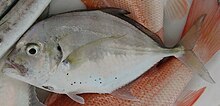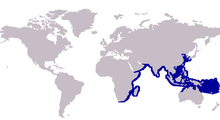Malabar trevally
| Malabar trevally | |
|---|---|

| |
| Scientific classification | |
| Domain: | Eukaryota |
| Kingdom: | Animalia |
| Phylum: | Chordata |
| Class: | Actinopterygii |
| Order: | Carangiformes |
| Family: | Carangidae |
| Genus: | Carangoides |
| Species: | C. malabaricus
|
| Binomial name | |
| Carangoides malabaricus (
Schneider , 1801) | |

| |
| Range of the Malabar trevally | |
| Synonyms | |
| |
The Malabar trevally (Carangoides malabaricus), also known as the Malabar jack, Malabar kingfish or nakedshield kingfish, is a
Taxonomy and naming
The Malabar trevally is one of 21 species in the genus Carangoides which falls into the jack and horse mackerel family Carangidae, the Carangidae are part of the order Carangiformes.[2]
The Malabar trevally was first
In English, the species nearly always goes under theDescription
The colour of the Malabar trevally is usually a silver overlain by a bluish-grey hue on the upper side of the fish fading to a silvery white on the underside and lower flanks. The opercle has a single small black spot on the upper margin, and the tongue is a distinctive greyish brown to brown.[7] The caudal fin, soft dorsal and anal fins are pale greenish yellow to dusky, while other fins are hyaline in appearance. The tips of the dorsal, anal and caudal fins are occasionally edged in a shade of white.[8]
Distribution and habitat
The Malabar trevally is broadly distributed in the tropical and subtropical regions of the Indian and Pacific Oceans. It occurs from South Africa and Madagascar in the west,[5] north along the east African coast and into the Persian Gulf, but has not been recorded from the Red Sea[9] since 1860, where a capture was reported under the name Caranx malabaricus.[10] Its range stretches east to Sri Lanka, Thailand, Indonesia, and a number of small Pacific islands including Vanuatu and New Caledonia. It reaches as far north as Japan, and south to northern Australia. The species is rare in a number of Pacific nations, including Taiwan and Japan, with only a few recorded captures.[11]
The species lives in a variety of inshore habitats, generally present in waters 30 to 140 m deep[9] on coral and rocky reefs. Juveniles tend to school in shallow sandy bays and are able to tolerate moderately turbid waters.[11] At least one recorded capture from an estuary in Thailand has been reported.[12]
Biology

The Malabar trevally often schools, especially as juveniles in shallow bays, becoming more solitary as they age.[6]
The species is not particularly aggressive, feeding on small
Little is known of its breeding cycle, with the only publication on the subject part of a 1984 study in Indian waters. The Malabar trevally's breeding period was reported as between February and October in this location, with the main peak from July to September.
Relationship to humans
The Malabar trevally is of minor importance to
References
- . Retrieved 19 February 2022.
- ISBN 978-1-118-34233-6. Archived from the originalon 2019-04-08. Retrieved 2019-11-24.
- ^ ISBN 978-0-643-09334-8.
- ^ a b Froese, Rainer; Pauly, Daniel (eds.) (2007). "Carangoides malabaricus" in FishBase. November 2007 version.
- ^ .
- ^ ISBN 0-8248-1895-4.
- ^ ISBN 92-5-104587-9.
- ^ ISBN 1-86825-394-5.
- ^ ISBN 0-8248-1808-3.
- ^ Ludwig, Albert Carl; Gotthilf Günther (1860). Catalogue of the Fishes in the British Museum. The Trustees. p. 437.
- ^ a b Lin, Pai-Lei; Shao, Kwang-Tsao (16 April 1999). "A Review of the Carangid Fishes (Family Carangidae) From Taiwan with Descriptions of Four New Records". Zoological Studies. 38 (1): 33–68. Archived from the original on 2012-02-29. Retrieved 2007-12-03.
- S2CID 84019167.
- ^ ISSN 1303-2712.
- ^ Salman, Nadir A.; Al-Mahdawi, Ghaith J.; Heba Hassan M.A. (2005). "Gill rakers morphometry and filtering mechnism [mechanism] in some marine teleosts from Red Sea coasts of Yemen". Egyptian Journal of Aquatic Research. 31: 286–296.
- .
- ^ ISSN 0379-5136.
- .
- S2CID 85573659.
- ISBN 1-58008-452-4.

